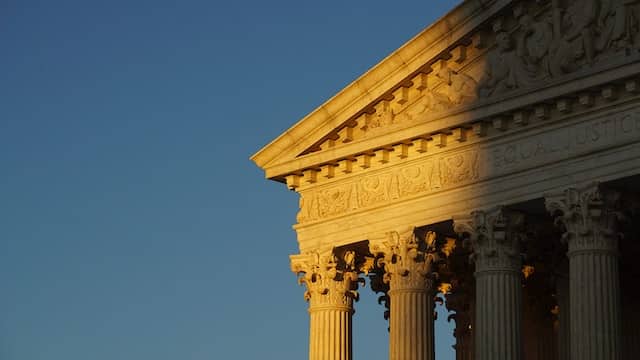The U.S. Supreme Court returns to work Monday for the 2022-’23 term. After last year’s colossal decision to overturn Roe v Wade, what can we expect this year from the 6-3 conservative supermajority of Justices?
Court Could Cement Its Conservative Stamp
The Supreme Court’s 2021-’22 term went out with a proverbial bang, overturning 50 years of precedent by dissolving the Constitutional right to abortion in its ruling in Dobbs v Jackson Women’s Health Organization. In fact, six of the 15 major cases last term were decided by the supermajority.
“Predicting ‘the blockbuster case’ is always difficult,” David Janovsky, Analyst for the Constitution Project at POGO (Project on Government Oversight) , tells Political IQ. “The Court’s docket is far from set for its full term, so there will obviously be more cases that get added.”
That said, the Court could further cement its conservative bona fides with several cases already on the docket.
For instance, Creative LLC v Elenis picks up where Masterpiece Cakeshop v Colorado Civil Rights Commission left off. In that 2018 case the Court ruled that Colorado’s constitution had violated its obligation to treat religious expression neutrally when its Civil Rights Commission ordered a baker to serve same-sex weddings.
In Creative LLC, the Court will rule whether a website that caters to weddings must offer “speech” for those whom its owner would otherwise refuse (LGBTQ customers).
Some other cases could impact environmental regulation (Sackett v EPA), Immigration law (United States v Texas), affirmative action and elections (more on the latter two below).
Sudria Twyman, Social Policy & Politics Fellow at Third Way, says we’ll get a sense of whether the Court will be more or less right-leaning this year fairly quickly—by the very questions the Justices ask during oral arguments.
“Most of the Justices have a pretty set style of questioning, especially some of the ones who have been on the Court a little bit longer,” she explains. “Scholars have deciphered how they ask questions and what their responses are, and what that means for their legal reasoning.”
Court Returning Just Before the Midterms
The Court, of course, is returning to work roughly a month before Americans head to the polls for the midterm elections—or sooner in many cases, given early voting.
And just days before Election Day the Court takes up a pair of high-profile cases questioning affirmative action at colleges and universities. On October 31, they’ll hear arguments in Students for Fair Admissions v President and Fellows of Harvard College and Students for Fair Admissions v University of North Carolina. Both involve challenges to how the schools sometimes factor race into the admissions process.
“It’s always hard to speculate how the Court’s business is going to intersect with elections,” says Janovsky, “except to say that, clearly, people are paying attention to what the Court is doing.”
Cases on Docket Could Impact Future Elections
Twyman doesn’t expect the affirmative action cases to impact the midterms because most voters will have made up their minds by October 31, but there are a couple of cases that could exert tremendous influence on how we vote in future elections. Because they’ve already received some media attention, she thinks voters could have them in mind when they cast their ballots.
In Moore v Harper, the state of North Carolina is advancing a Constitutional argument called the “independent state legislature theory.” It asserts that a state’s legislators have sole authority over its elections, to the exclusion of its governor—or its courts.
The Court agreed to put this case on the docket last February, but as yet, no date has been set for arguments.
The case of Merrill v Milligan targets the Voting Rights Act. The Justices will be asked to overturn a lower court ruling that ordered Alabama to create a second Black congressional district centered in the state’s heavily rural Black Belt.
A three-judge panel had found that Alabama violated the Voting Rights Act by dividing the Black Belt into multiple districts.
The Court hears arguments in this case right out of the gate—October 4.
Public Confidence in Supreme Court at Half-century Low
The Justices will take their seats with public confidence at a 50-year low, according to Gallup. Its polling from June found only 25% of Americans have confidence in the Court, a nine-point drop from only a year prior.
Janovsky says one “no-brainer” the Court could do “today” to boost the public’s perception is undertake ethics reform.
“We’ve heard a certain amount recently about how the Supreme Court is just about the only, if not the only, court in the country that doesn’t have a formal written ethics code for its members,” he notes. “I think that would help show that the Justices don’t perceive themselves as above the laws they’re entrusted with.”
The reform at the top of Janovsky’s wish list is recusals, “whether it’s stock ownership, whether it’s a family member’s activity that could give a Justice a certain bias in a case, or whether it’s just the appearance of a conflict, judges are supposed to recuse themselves but Supreme Court Justices often don’t.”
The Ginni Thomas Factor
A “family member’s activity” leads to Virginia “Ginni” Thomas, the wife of Justice Clarence Thomas, who attended the January 6, 2021 rally that devolved into the deadly insurrection on the U.S. Capitol.
Justice Thomas did not recuse himself when former President Trump asked the Court to block the House investigative January 6 Committee from gaining access to his White House records. When the Court declined to block release of the documents, Thomas was the only Justice who dissented, siding with Trump.
Meanwhile, Mrs. Thomas has agreed to be interviewed by the Committee. On Friday, Committee member Rep. Zoe Lofgren (D-CA) said that as a member of Congress, “it’s not for me to tell Justices when they should recuse,” but when it comes to January 6-related issues, “I think that many feel that Justice Thomas would have been well advised to consider that standard when hearing that case.”
Janovsky says if the Court doesn’t step forward with reforms like recusals, “Congress has shown that it’s ready to step in.”
A House bill known as the Supreme Court Ethics, Recusal, and Transparency Act of 2022 was advanced in the House in May. But it was along Democratic-majority lines. Ranking Republican on the Judiciary Committee, Rep. Jim Jordan of Ohio, has pretty much said the bill is dead in the water if his party becomes the majority after the midterms.
Can the Newest Supreme Court Justice Make a Difference?
The Court also returns with a history-making new Justice. Ketanji Brown Jackson was sworn in as the first-ever Black woman Justice on June 30th.
She’ll be one of only three liberal voices against the conservative supermajority. Yet both Janovsky and Twyman say she can, and will, have an influence.
In fact, Twyman says, she’s already impacting the Court. “Just having the first female African-American Supreme Court Justice was a monumental accomplishment and a wonderful victory for the Supreme Court and for diversity and for the country.”
While Janovsky points out, “There is a lot of negotiation and decision-making that goes on behind the scenes, and I think the different perspectives that every Justice brings to that will have some sort of impact, even if it’s just how a dissent is framed.”
Twyman agrees. “Justice Ruth Bader Ginsburg had a great impact with her dissents. Justice Sotomayor does as well, especially in this last term,” she notes. “I think Justice Jackson will have an equally substantial impact with dissents. And maybe that new voice and that new perspective will bring to some of the conservative Justices a perspective that they had never heard before and didn’t really understand until she got on there.”
Adds Janovsky, “One year’s dissents may well become majority opinions down the line or shape the law in other ways.”


